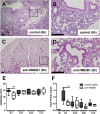High-mobility group box 1 and the receptor for advanced glycation end products contribute to lung injury during Staphylococcus aureus pneumonia
- PMID: 24342460
- PMCID: PMC4057161
- DOI: 10.1186/cc13162
High-mobility group box 1 and the receptor for advanced glycation end products contribute to lung injury during Staphylococcus aureus pneumonia
Abstract
Introduction: Staphylococcus (S.) aureus has emerged as an important cause of necrotizing pneumonia. Lung injury during S. aureus pneumonia may be enhanced by local release of damage associated molecular patterns such as high-mobility group box 1 (HMGB1). In the current study we sought to determine the functional role of HMGB1 and its receptors, toll-like receptor 4 (TLR4) and the receptor for advanced glycation end products (RAGE), in the injurious host response to S. aureus pneumonia.
Methods: Pneumonia was induced in wild type (Wt), TLR4 deficient (tlr4-/-) and RAGE deficient (rage-/-) mice by intranasal inoculation of 1 × 107 colony-forming units (CFU) of a USA300 S. aureus. In a separate set of experiments, Wt mice were injected intraperitoneally with a monoclonal anti-HMGB1 antibody or an isotype matched control antibody immediately before and every 24 hours after intranasal infection of S. aureus. Mice were sacrificed at 6, 24, 48 or 72 hours after infection for harvesting of blood and organs.
Results: S. aureus pneumonia was associated with HMGB1 release in the bronchoalveolar compartment peaking after 24 hours. Anti-HMGB1 attenuated lung pathology and protein leak and reduced interleukin-1β release 6 hours after infection, but not at later time points. RAGE deficiency more modestly attenuated lung pathology without influencing protein leak, while TLR4 deficiency did not impact on lung injury.
Conclusion: These data suggest that HMGB1 and RAGE, but not TLR4, contribute to lung injury accompanying the early phase of S. aureus pneumonia.
Figures






Comment in
-
HMGB1 as a drug target in staphylococcal pneumonia.Crit Care. 2014 Mar 31;18(2):131. doi: 10.1186/cc13810. Crit Care. 2014. PMID: 25029244 Free PMC article.
References
-
- Francis JS, Doherty MC, Lopatin U, Johnston CP, Sinha G, Ross T, Cai M, Hansel NN, Perl T, Ticehurst JR, Carroll K, Thomas DL, Nuermberger E, Bartlett JG. Severe community-onset pneumonia in healthy adults caused by methicillin-resistant Staphylococcus aureus carrying the Panton-Valentine leukocidin genes. Clin Infect Dis Official Pub Infect Dis Soc Am. 2005;17:100–107. doi: 10.1086/427148. - DOI - PubMed
Publication types
MeSH terms
Substances
LinkOut - more resources
Full Text Sources
Other Literature Sources

